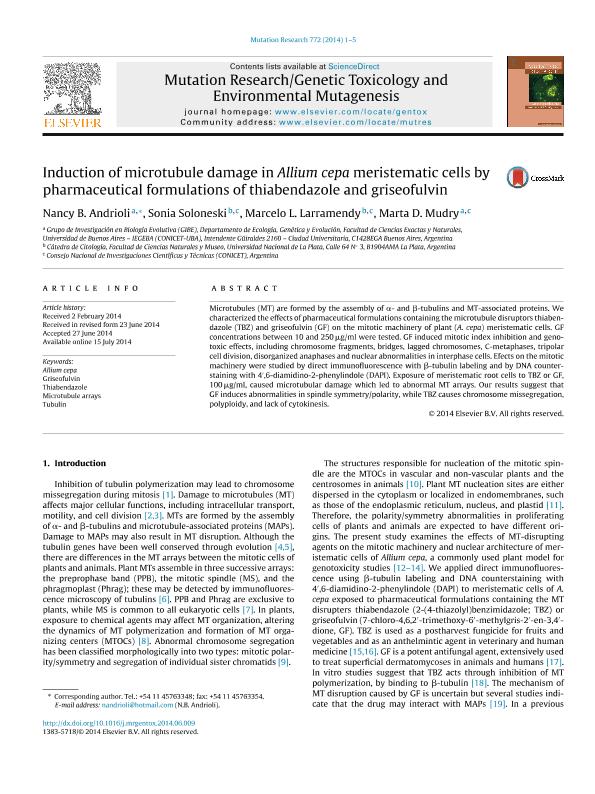Artículo
Induction of microtubule damage in Allium cepa meristematic cells by pharmaceutical formulations of thiabendazole and griseofulvin
Andrioli, Nancy Beatriz; Soloneski, Sonia Maria Elsa ; Larramendy, Marcelo Luis
; Larramendy, Marcelo Luis ; Mudry, Marta Dolores
; Mudry, Marta Dolores
 ; Larramendy, Marcelo Luis
; Larramendy, Marcelo Luis ; Mudry, Marta Dolores
; Mudry, Marta Dolores
Fecha de publicación:
09/2014
Editorial:
Elsevier Science
Revista:
Mutation Research. Genetic Toxicology And Environmental Mutagenesis
ISSN:
1383-5718
Idioma:
Inglés
Tipo de recurso:
Artículo publicado
Clasificación temática:
Resumen
Microtubules (MT) are formed by the assembly of - and -tubulins and MT-associated proteins. We characterized the effects of pharmaceutical formulations containing the microtubule disruptors thiabendazole (TBZ) and griseofulvin (GF) on the mitotic machinery of plant (A. cepa) meristematic cells. GF concentrations between 10 and 250 g/ml were tested. GF induced mitotic index inhibition and genotoxic effects, including chromosome fragments, bridges, lagged chromosomes, C-metaphases, tripolar cell division, disorganized anaphases and nuclear abnormalities in interphase cells. Efects on the mitotic machinery were studied by direct immunofluorescence with -tubulin labeling and by DNA counterstaining with 4 ,6-diamidino-2-phenylindole (DAPI). Exposure of meristematic root cells to TBZ or GF, 100 g/ml, caused microtubular damage which led to abnormal MT arrays. Our results suggest that GF induces abnormalities in spindle symmetry/polarity, while TBZ causes chromosome missegregation, polyploidy, and lack of cytokinesis.
Palabras clave:
ALLIUM CEPA
,
GRISEOFULVIN
,
MICROTUBULE ARRAYS
,
THIABENDAZOLE
,
TUBULIN
Archivos asociados
Licencia
Identificadores
Colecciones
Articulos(IEGEBA)
Articulos de INSTITUTO DE ECOLOGIA, GENETICA Y EVOLUCION DE BS. AS
Articulos de INSTITUTO DE ECOLOGIA, GENETICA Y EVOLUCION DE BS. AS
Citación
Andrioli, Nancy Beatriz; Soloneski, Sonia Maria Elsa; Larramendy, Marcelo Luis; Mudry, Marta Dolores; Induction of microtubule damage in Allium cepa meristematic cells by pharmaceutical formulations of thiabendazole and griseofulvin; Elsevier Science; Mutation Research. Genetic Toxicology And Environmental Mutagenesis; 772; 9-2014; 1-5
Compartir
Altmétricas



